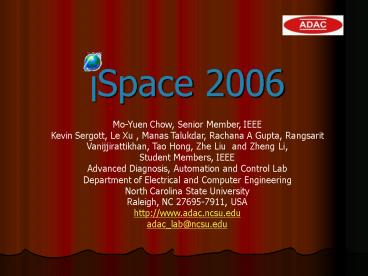Space 2006 PowerPoint PPT Presentation
1 / 17
Title: Space 2006
1
Space 2006
Mo-Yuen Chow, Senior Member, IEEE Kevin Sergott,
Le Xu , Manas Talukdar, Rachana A Gupta,
Rangsarit Vanijjirattikhan, Tao Hong, Zhe Liu
and Zheng Li, Student Members, IEEE Advanced
Diagnosis, Automation and Control Lab Department
of Electrical and Computer Engineering North
Carolina State University Raleigh, NC 27695-7911,
USA http//www.adac.ncsu.edu adac_lab_at_ncsu.edu
2
iSpace Intelligent Space
Human-machine interaction in iSpace
- Intelligent Space (iSpace) is a concept to
effectively use distributed sensors, actuators,
robots, computing processors, and information
technology over a physically and/or virtually
connected space. E.g. a room, a corridor, a
hospital, an office, or a planet. - iSpace fuses global information within the
space of interest to make intelligent operation
decision such as robot navigation, remote surgery
etc.
Star trek Enterprise ship
3
iSpace The Concept
4
iSpace - Advantages and Applications
- Advantages
- Not limited by the physical space.
(Tele-operation, Tele-presence) - Fuse global information for global optimal
solutions. - Scalability - Easy to add sensors and actuators
with little incremental cost and without heavy
structural changes. - Applications
- Manufacturing plant monitoring
- Nursing homes or hospitals
- Tele-robotics Tele-Medicare etc
5
ADAC iSpace - Prototyping project
Johnny6 plays fetch
- Game rules
- The space with obstacles is continuously
monitored by a webcam. - An Unmanned Ground Vehicle, (UGV) is to be
controlled to go from its current location to a
specific destination chosen by a user in a remote
computing interface as quickly as possible while
avoiding collisions with obstacles.
Johnny5
6
Modules on Main controller
Template matching
Quadratic curve fitting path tracking controller
Fast marching for path planning avoiding obstacles
7
Time delay issue
- Network delay component
- Sensor to controller delay (Image Acquisition)
- Controller to actuator delay (Commands from
controller to the UGV) - Processing or computational delay component
- Non-real time Computational delay (Initial image
processing, path planning) - Real time Computational delay (continuous image
processing, motion control)
Histogram of network delay
The mean is 0.129 second, the median is 0.01
second
Image Acquisition delay
Average 0.2 seconds
Image Processing delay
Non-real time 1.2 s, real time 0.02 s
8
Network-based control and GSM
- Gain Scheduler Middleware (GSM) is a technology
developed in ADAC that allows the communication
network to be transparent to controller and
remote system, alleviating the adverse effects of
network delay.
Raleigh, USA to Tokyo, Japan
9
iSpace research _at_ 2006 Network based integrated
navigation system
An efficient and generic, vision based UGV
navigation system, integrating different modules.
Obstacle information
Goal seeking with Harmonic Potential Field
Path planning with HPF
HPF with motion controller
10
iSpace with HPF
Actual workspace images with different
backgrounds, different obstacle shapes and
sizes. Red line is actual path and white line is
the ideal path.
11
Resource Allocation
- Adaptive multiple sampling rate scheduling
(AMSRS) - Maximizing information transmission through
resource limited network - e.g., bandwidth limited IP based Ethernet
- Preventing signal aliasing by analyzing its
frequency domain characteristics - e.g., measurements of UVs wheel rotation speed
(right figures) - Real-time allocation (scheduling) decision making
- low computation overhead optimization
12
Petri-Net Modeling of iSpace
- Petri Nets
- a mathematical graphical tool for process
modeling - can be applied to several research areas
- Discrete event system design
- Fault detection and diagnosis
- Process scheduling
- Example
- Robots serving process
- Moving a plate from A to B
- Putting a cup on the plate
- (done by people)
- Moving a plate from B to A.
13
Network Delay Generator
- Network Delay Generator (NDG)
- can be used to
- simulate real network delay
- provide controllable network delay
- provide various types of delay
- verify experiment results
Real network (random uncontrollable delay)
NDG (controllable delay)
14
iSpace -Virtual Reality
- iSpace simulation in virtual reality.
- Allows visualization of simulation results.
- Different environments can be simulated and the
corresponding virtual worlds generated. - Allows development of better technologies by
virtual prototyping.
15
iSpace Summary and Future Research
- ADAC iSpace _at_ 2006 A network based
multi-sensor, multi-actuator, large scale,
Mechatronics system - Research and contribution
- Network delay compensation with GSM.
- Network based integrated navigation system with
edge detection and HPF. - Resource allocation
- Applications
- Manufacturing plant monitoring
- Nursing homes and hospitals
- Tele operations (e.g. space operations, remote
surgery) - Military application
- Future research
- Real time scheduling, Dynamic obstacle avoidance,
Collaborative formation control and Network
security
16
ADAC Members
http//www.adac.ncsu.edu adac_lab_at_ncsu.edu
17
(No Transcript)

